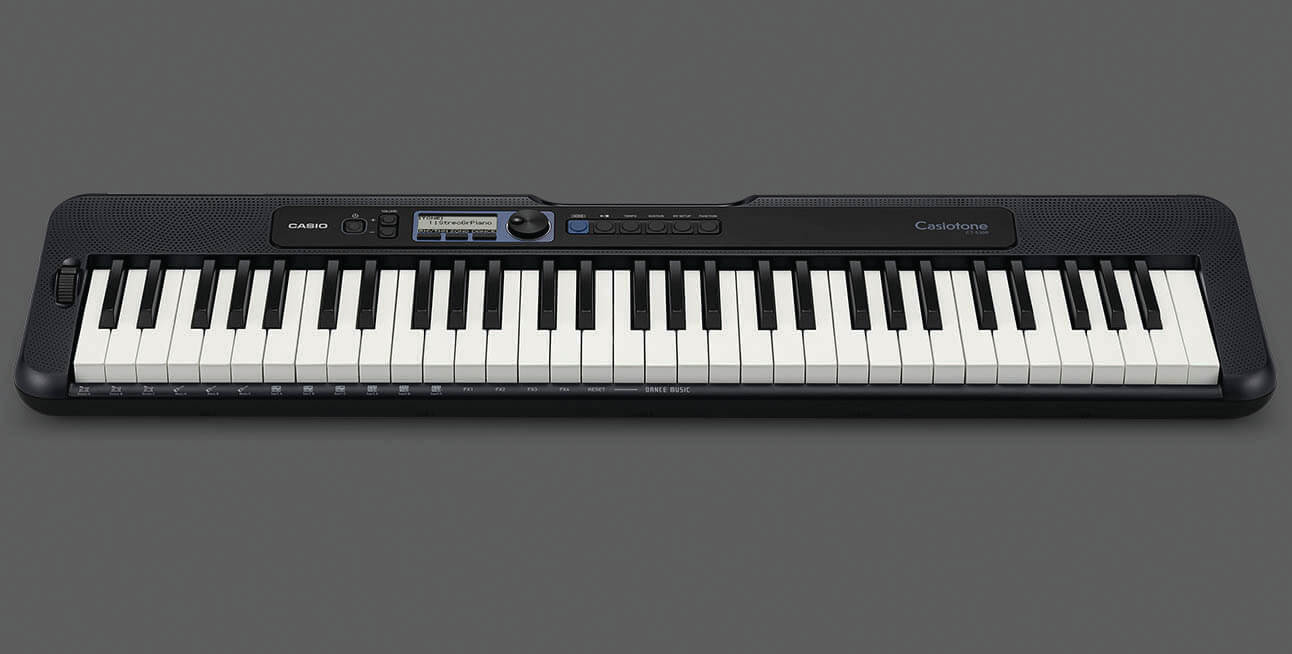For those of us of a certain age, the name Casiotone evokes either one of two emotions: fevered nostalgia or…well, perhaps a slight chuckle. I get it, but for me, the nostalgia wins out. A Casio keyboard, for good or bad, was one of the first instruments I ever used to pluck out a few notes. It was magic, in a time where no such magic existed for me. Being older now, I’m fortunate enough to own a Moog, and ARP, even a Mellotron in my personal keyboard arsenal (not bad for a guitar player).

But those old Casio keyboards hold a certain place in my heart. Which is why, when we met with the folks from Casio at NAMM this past year, and they showed us around their new Casiotone models (in addition to some of their higher-end digital pianos), a little part of me started to warm up inside.
Cut to a few months later, and the Casiotone CT-S300 showed up at the office.
So, let’s dig in.
For starters, those chuckles I spoke about earlier are largely due to Casio’s supposed placed in the cheese-tastic hall of fame of 80’s synth sounds. And sure, to some degree, that’s one way to look at it. For affordable keyboards back in the day, you were obviously going to be limited in the on-board sounds, waveforms and polyphony options. And to that end, having played a few vintage Casio keyboards recently, I must say they do actually hold up fairly well, all things considered. Sure, they’re no Prophet or Minimoog or (gasp) DX-7, but they were never designed to be. And those looking to add an authentic vintage sound to their more modern synth lineups might just want to check one out, if only to add some 80’s fun to the mix. But we’re straying from the matter at hand…
If you go in with the right expectations, you might be very pleasantly surprised with the new Casiotone lineup. We certainly were with the CT-S300 that we got ahold of. For starters, the keybed is very playable. It’s the standard plastic key action you’ll find on a lot of synths and MIDI controllers in this price range, so no surprises there. Although we do appreciate non-teeny-tiny miniature keys for once. One surprise we weren’t prepared for, however, was the pitch wheel – a very nice addition that makes note performance much more expressive than Casiotones from days of yore. Even more impressive is that you’ve got a few options for touch sensitivity, meaning you could use this as a MIDI controller with velocity, in addition to the included sound sets.
Speaking of which, there are a TON of on-board sounds to play around with. Thankfully, navigation is pretty simple, even for menu-diving haters like us. A big, giant wheel sits in the middle of the panel and allows super-easy access to all the sounds and parameters. The small LCD screen is easy to read, even if it is limited in the number of character and rows it can display. In fact, everything about navigating this keyboard is easy, just like the old days, because you’ve only got a few buttons and controls to fiddle about with. In some ways, this is actually refreshing coming off a deep-dive with some of KORG’s more recent offerings.

The sounds are where the new Casiotone lineup really shines. In addition to some surprisingly usable synth sounds, you get access to a whole host of great piano sounds, pads and other instruments that you’re not gonna find on a lot of comparable digital synths. If you want to add some basic electric piano to your mix, you’d normally have to find some DAW plug. Which is fine, except sometimes you just want an instrument to handle the job, and the Yamaha Reface CP is about twice the price with way fewer sounds, smaller keys and no wheel. The Casiotone also provides an impressive 48-note polyphony and a 5-octave keybed, two more octaves than the Reface line and most other synths you might be considering.
You’ve got two adequate built-in speakers, which can of course be bypassed with an audio output to your mixer, powered speakers or audio interface, as well as MIDI control over USB. Would we have preferred to have real 5-pin MIDI ins and outs? Sure, but at this price, we’re not gonna nitpick. Especially considering you can power it with batteries and the entire unit weighs next to nothing, so you can take it practically anywhere with no hassle.
So, what’s our verdict? For $150, it’s almost silly not to pick one up for fun. Snobby synth-heads may snicker at the Casio name, but I think this retro-flavored initiative is one way the modern-day Casio is addressing some of the inaccurate views the public maybe still hold on the quality of their older products. If there is an image problem with Casio keyboards, this is one giant step in the right direction to squelch some of that past snobbery.
PROS:
inexpensive, good selection of sounds, portable, decent keybed
CONS:
no traditional MIDI I/O
STREET PRICE:
$149
